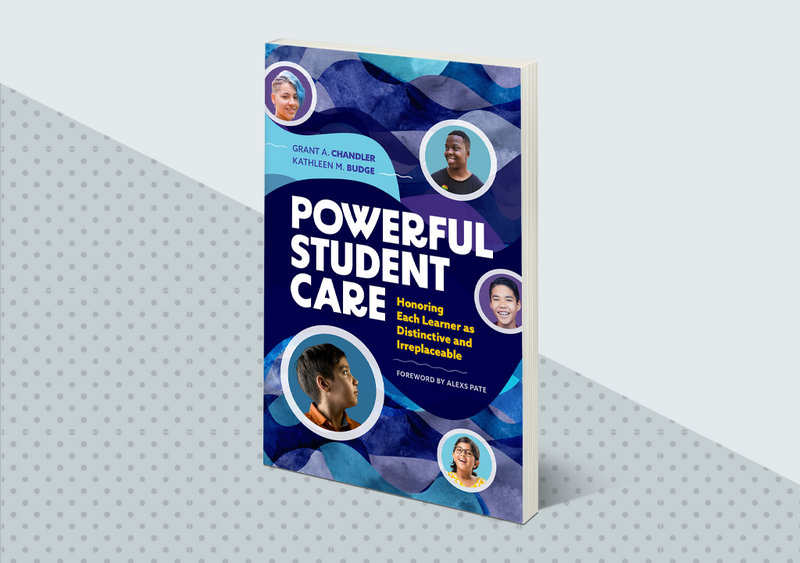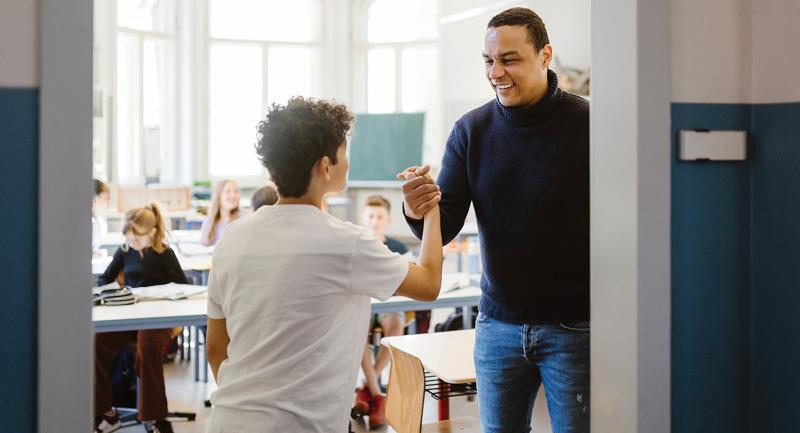Transformational Learning Principle
Nurture—Cultivate Belonging: Educators prioritize relationship building in physical and virtual spaces. They strive to create learning cultures that ensure students’ safety and belonging and foster durable skills such as empathy, creativity, and collaboration.
From the moment students set foot on school grounds, they begin to “pick up signals about whether or not they fit in” (Barron & Kenny, 2021). As they interact with their peers, educators, and the physical environment, as well as school and classroom norms, these perceptions “pile up” and students ascertain quickly whether they belong or they don’t.
Let’s consider what happened with Cienna.
Cienna is 8 years old. She is timid and has had difficulty making friends. She especially doesn’t like coming to school on Fridays because everyone wears their school spirit T-shirts, and she doesn’t have one. Since her grandmother’s death, Cienna has been completing her homework less and less frequently and often arrives late to school. She’s also under the impression that her teacher is “mad” at her for not bringing school supplies at the start of the year.
Students in Cienna’s school produce a daily broadcast of the morning news, and a few students are soon to be chosen from her class to participate in the next broadcast. When Ms. McNeil-Davis, Cienna’s teacher, explains only students with perfect attendance and no tardiness will be considered, Cienna bursts into tears and takes refuge under a table at the back of the room. She refuses to return to her desk, and for the next two days, Cienna heads straight under the table.
Ms. McNeil-Davis attempts to contact Cienna’s mother and seeks help from the school principal. She describes Cienna as a difficult child, telling the principal, “I can’t get her to talk to me. It’s making me crazy, and I don’t know what else to do. I can’t teach her when she’s under the table.” Ms. McNeil-Davis is overwhelmed with trying to support her class of 27 students with “so many [different] needs.”
Yet Cienna doesn’t spend three days hidden under the table because she’s trying to disrupt the classroom or cause her teacher undue stress. She’s a young child traumatized by the recent death of her grandmother and the separation anxiety triggered by spending evenings with various extended family members while her mother picks up extra shifts at work to make ends meet. Ms. McNeil-Davis attempts—to no avail—to lure Cienna out by offering her a bean bag, a rug, and another comfortable location. But Cienna refuses to budge. She is simply reacting to a series of signals that she believes tell her she doesn’t belong.
Every educator sends signals to students which, consciously or unconsciously, determine who experiences belonging and who doesn’t. When students perceive they do not belong, they are at risk for a host of adverse social, emotional, and academic consequences such as anxiety, self-defeating behavior, and a decline in academic learning. A sense of belonging, on the other hand, results in an abundance of positive personal, social, and academic outcomes like self-confidence, self-worth, prosocial behavior, and academic achievement (Barron & Kinney, 2021).
Cienna’s story (a composite) is excerpted from Powerful Student Care: Honoring Each Student as Distinctive and Irreplaceable (ASCD, 2023), a book we wrote to introduce what we view as a much-needed humanizing approach to education and that aligns with the Transformational Learning Principle on Cultivating Belonging. Our aim is to provide a touchstone for educators’ professional practice that references the preciousness of each human life. Without this touchstone, it can too easily become commonplace to overlook students’ humanity. Recognizing Dehumanization
We have long known that belonging is a fundamental human need and a precursor to self-worth, self-confidence, and agency (Maslow, 1968). Yet many children experience school as alienating and fail to thrive in a system that is too often dehumanizing. This is especially true for children of color, children who identify as LGBTQIA+, emerging bilingual students, immigrants, refugees, children with IEPs, and children experiencing poverty (Cobb & Krownapple, 2019; Olson, 2009).
In a recent survey conducted by the Quaglia Institute, only 39 percent of U.S. students in grades 6–12 reported feeling like they are valued members of their school community. The results for younger students were not more encouraging: just 45 percent of students in grades 3–5 reported feeling important in their classrooms.
Teachers tell us that high-stakes accountability systems force them to prioritize standardized test performance above all else. Right out of the gate, they must focus on content that helps students score well on end-of-year accountability tests. In some states, educators’ performance evaluations are directly tied to how many students demonstrate proficiency.
District and school-based administrators face similar pressure, as test scores published in local media can relegate a school’s measure of success to a single number. Educators find this “herding” of students toward test proficiency demoralizing (Santoro, 2011).
Certain approaches to classroom management further exacerbate this. Punitive approaches that focus on “fixing students” rather than “fixing the system” worsen the dehumanization learners experience. Such systems inherently create winners and losers, often rewarding students who already meet expectations while alienating those who need support tailored to their unique needs, interests, and identities.
Unsurprisingly, many students and families respond to these dehumanizing approaches by choosing not to engage with school; absenteeism is one of the most challenging issues we face in education today (Malkus, 2024).
In the words of Floyd Cobb and John Krownapple, authors of Belonging Through a Culture of Dignity (2019), we urgently need to “dust off our knowledge of Maslow” and prioritize the belonging gap. Belonging is the foundation for learning. It’s the step before academic achievement (p. 45).
Belonging is a fundamental human need and a precursor to self-worth, self-confidence, and agency.
How to Intentionally Cultivate Belonging
Based on our experience and research, we suggest four transformative actions to cultivate belonging in your school or classroom:
Action 1: Nurture a community of difference.
Begin cultivating belonging by co-creating a community of difference with your students. A community of difference is a concept borrowed from scholar Carolyn Shields (2004). Such a community is based on “respect for difference and on the absolute regard for the intrinsic worth of every individual.” Accordingly, fostering a community of difference centers on developing a deep knowledge of self and others.
To nurture the community, work to integrate the five tenets central to Powerful Student Care (see fig. 1) into everything you do—the structures, processes, routines, and rituals you use; the methods of instruction you choose; the curricular materials you deploy; the values you hold; and the nature of your relationships with your students.
While all of the tenets cultivate aspects of belonging, the first two are particularly vital: “Each student is welcomed to be part of our community” and “Each student is a valued member of our community.”
Action 2: Ensure each student is unconditionally welcomed.
As you welcome each student into the community, let an ethic of hospitality be your guide. Claudia Ruitenberg (2015) offers this transformative philosophy, saying, “The ethic is all about . . . giving place [belonging, relatedness, rootedness] to a guest [the student]” (p. 14). However, unlike the sort of hospitality we offer in our home, for which we would typically expect our guests to reciprocate, we can have no expectation students will do the same. We do not welcome each student because we are virtuous people, Ruitenberg explains. We do so because it is our responsibility, and it is necessary if they are to learn from us. In this way, students experience belonging in the form of unconditional appreciation, validation, acceptance, respect, inclusion, support, and fair treatment.
An ethic of hospitality requires that you decenter yourself. Even when students struggle to meet your expectations, the welcome you have extended them cannot be diminished. It is in these moments that you are afforded the privilege of building authentic bridges into their lives. Suppose Ms. McNeil-Davis’s professional practice had been guided by an ethic of hospitality; she might have examined her own mental models and questioned her decision to create an inequitable context in which Cienna was not allowed to vie for the opportunity to participate in the news broadcast.
Action 3: Ensure each student knows they are valued.
Belonging begins when students are welcomed, but it is fortified when they understand they are equally valued as the unique and precious human being they are. Cobb and Krownapple (2019) refer to equal worth as human dignity. They call on educators to develop dignity-conscious relationships with students. In such relationships, educators accept students’ multidimensional identities without judgment. They trust students, treat them fairly, respond to their concerns, and promote the development of agency in each of them. Perhaps most important, educators accept responsibility for their action (or lack of action) and apologize if they cause harm (Hicks, 2018).
By safeguarding each student’s human dignity, you cultivate belonging. In this way, students experience belonging as sufficient safety and freedom to explore their developing sense of selfhood and maintain a deep sense of self-worth. They know their voice matters and they have a place at the table.
By safeguarding each student’s human dignity, you cultivate belonging.
Action 4: Understand and confront the barriers to belonging.
Three significant barriers undermine our efforts to cultivate belonging in schools: stereotyping, othering, and violations of human dignity. When left unchecked, they create toxic learning environments where students feel judged, excluded, and devalued.
Stereotyping is attributing characteristics, behaviors, or traits to individuals or groups of people based on generalized, unfair, or inaccurate beliefs and assumptions. It produces a distorted form of guilt in our students, which “triggers cynicism, anger, apathy, and a general sense of opposition to education” (Pate, 2020). They come to believe it doesn’t matter what they do because the world already sees them as guilty. To illustrate, it is possible that Ms. McNeil-Davis held implicit bias related to Cienna’s socioeconomic status or simply toward parents whose children don’t attend school regularly or don’t show up on time.
Othering is the opposite of belonging and occurs when students are dehumanized for their differences, treated unfairly based on biased perceptions, forced to “hide” important aspects of themselves, or have their lived experiences invalidated (Cobb & Krownapple, 2019). When Ms. McNeil-Davis excluded students like Cienna for imperfect attendance, she may have been stereotyping or othering them. Additional examples of othering include mispronouncing a student’s name, discussing a student’s accommodations (e.g., their 504 plan or IEP) in front of their peers, or dismissing a student’s affirmed identity.
Human dignity can be violated in many ways, and we all do it, especially when we feel our own dignity is vulnerable. One of the most harmful ways we violate our dignity and that of our students is through blaming them when they struggle to learn what we have attempted to teach them or failed to meet our behavioral expectations. Case in point, when Ms. McNeil-Davis sought help from the principal, she deflected her responsibility and placed blame on Cienna, labeling her “a difficult child.”
To prevent these barriers from taking root in your classroom or school, it is necessary to intentionally get to know your students and to marshal the courage to confront your own values, beliefs, and biases through reflection and introspection. We suggest educators engage in what we call “The Contemplative Practice,” which uses a guided inquiry protocol for better understanding your students and yourself. Educators are asked to respond to questions corresponding to each of the five tenets central to Powerful Student Care. These questions support them to: (1) analyze available information about their students and themselves, (2) engage in strengths-based planning to determine the best course of action, and (3) evaluate and reflect on the results of the action(s) taken, as well as changes in one’s mental models.
Cultivating Belonging: What Could Be More Important?
If we could get this Transformational Learning Principle right—cultivating belonging in each student—it has the potential to thwart the dehumanizing aspects of schooling. We are the ones who create the conditions that signal to students they belong or they don’t. To do better in this space, we must consistently bear in mind each student’s humanity. As we open our doors (in physical and virtual spaces) to students like Cienna—each with their own story, strengths, and challenges—what could be more important?
Reflect & Discuss
➛ In what specific ways might your teaching practice unintentionally signal to certain students that they don’t belong? How can you identify these signals?
➛ How might an “ethic of hospitality” change the way you respond when students struggle to meet your expectations?
➛ What is one immediate action you could take tomorrow to strengthen students’ sense of belonging in your classroom or school?
Powerful Student Care
If we want to really understand our students so that we can optimize instruction for them, we must think of each individual student as distinctive and irreplaceable.









